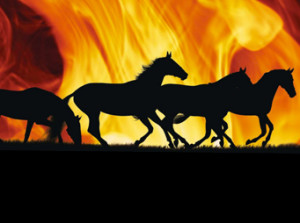Protecting Our Horses from the Threat of Wildfires
Click here to read the complete article212 – November/December, 2016
By William J. Given
 An uncontrolled fire burning in brushlands, grasslands, or woodlands is generally considered to be a wildfire. Depending on the ambient air temperature, lack of humidity, prevailing winds, topography, as well as the amount and type of vegetation, a wildfire can quite unexpectedly develop into a phenomenon known as a firestorm. A firestorm produces a convection air system, frequently reaching speeds of 60 miles per hour which can spread violently and rapidly across the landscape.
An uncontrolled fire burning in brushlands, grasslands, or woodlands is generally considered to be a wildfire. Depending on the ambient air temperature, lack of humidity, prevailing winds, topography, as well as the amount and type of vegetation, a wildfire can quite unexpectedly develop into a phenomenon known as a firestorm. A firestorm produces a convection air system, frequently reaching speeds of 60 miles per hour which can spread violently and rapidly across the landscape.
Horse properties surrounded by forests or rangeland with a wide variety of grasses and shrubs, commonly referred to as the wildland urban interface, are particularly at risk to wildfires. It should be no great surprise that many horse owners choose to live in these beautiful areas because they offer abundant pasture and have good access to riding trails. In an average year, about seven million acres are destroyed by wildfire. It should be noted that over the last 100 years, the amount of land ravaged by wildfires has almost doubled in 11 western states. Wildfires pose an increasing threat to residential communities as they encroach on undeveloped lands here in the United States.
Although wildfires can spark and spread at any time of the year, they commonly occur during hot, dry and windy weather. The National Weather Service, U.S. Forest Service, and state forestry agencies collect data and use it in the development of wildfire probability forecasts. This information is shared with local radio and television stations which often broadcast information and warnings when wildfire conditions exist in your area.
Wildfire Readiness
Wildfires can start as the result of a direct cause such as a lightning strike or indirectly from windblown embers landing on a combustible material such as hay or straw. In dry conditions, even gentle winds can blow an ember a mile or more before falling onto dried weeds piled up along the side of a barn or out-building. One of the most important preventive measures a horse owner can take to reduce his or her risks of suffering significant damage from a wildfire is to create a defensible space around all structures on his or her property. A defensible space is generally defined as a landscaped area created to minimize fire danger by the selective use of vegetation.
A defense zone can be pictured as three concentric circles drawn around the structures on your property. The first circle should extend out at least 30 feet out, 60 feet for the second circle, and the third out to 100 feet. The inner circle is the critical zone of protection. In this circle, your landscaping should be limited to grass and low-growing plants with a natural high moisture content. You can use slightly taller drought-resistant shrubs in the zone between 30 and 60 feet. Deciduous trees are recommended for the outer ring because they have a lower fuel volume than do evergreens.
Consider having a representative from your local Fire Marshall’s office inspect your property and recommend specific wildfire prevention measures. Your local fire department should know the exact location of your farm, how to access your property, how many horses you have on your property and where large volumes of water will be immediately available. These can make a real difference when firefighters are responding to a wildfire.
The priorities for disaster planning for farms and horse owners vary based on the type of facilities and the number of horses you have. However, you should assemble a disaster survival kit that includes: a full and complete list of all your horses, veterinary health records to include vaccination history and Coggin’s test results, as well as extra medication, if necessary. Make sure your kit contains front and side facing photographs, registration papers and bills of sale which will serve as proof of ownership.
Click here to read the complete article212 – November/December, 2016










